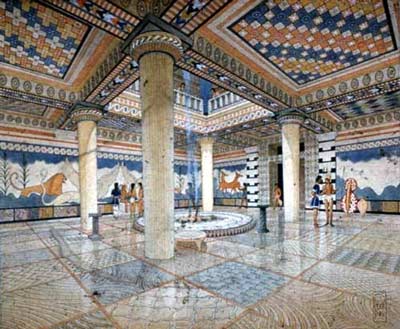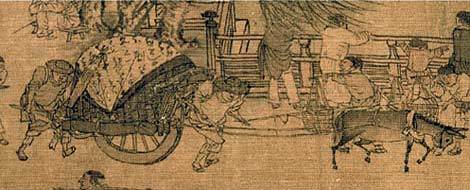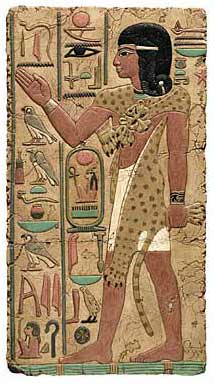
A Mycenaean palace – an example of waste expenditure
Neil Faulkner Archive | ETOL Main Page
Marxist History
Published online by Counterfire, 16 August 2010.
Copied with thanks from the Counterfire Website.
Marked up by Einde O’Callaghan for the Encyclopaedia of Trotskyism On-Line (ETOL).
The complex societies that emerged from the division of society into classes also created societies that were wasteful, violent, stagnant and crisis prone. Understanding why is the key to how history happens argues Neil Faulkner.

A Mycenaean palace – an example of waste expenditure |
The ‘urban revolution’ created the great imperial civilisations of the Bronze Age. But these civilisations were characterised by high levels of waste expenditure on war, monuments, and luxury – expenditure that was competitive and therefore cumulative.
The waste arose from the division of the world into antagonistic classes and rival states. And it resulted in super-exploitation of the peasantry that drained the economy of productive resources and reserves.
The imperial civilisations were therefore both economically stagnant and socially conservative. The classes and states which were their basis constituted formidable barriers to progress.
The Bronze Age impasse provides a useful occasion to pause and take stock. All the elements of complex society are now in place, so it is convenient to pose the question: how does history happen?
First, there is the development of technique. Progress can be defined as the accumulation of knowledge that makes possible better control over nature, increases in labour productivity, and an enlarged store of economic resources available for the satisfaction of human need.
Progress in this sense is not inevitable. Entire generations of peasants in, say, Shang China, Mycenaean Greece, or Norman England might live out their entire lives without ever experiencing a significant innovation in either agricultural or domestic equipment.
Only in modern capitalist society is the development of technique inherent in the mode of production. Marx, when making this point, explicitly states: ‘Conservation of old modes of production in unaltered form was, on the contrary, the first condition of existence of all earlier industrial classes.’
Progress in pre-capitalist society was accidental, not something intrinsic to the dynamic of the socio-economic system. In pre-class society, ecological crisis threatening the survival of human groups was probably of critical significance. The Neolithic Revolution seems to have been a response to global warming and a sharp decline in game.

A Chinese wheelbarrow – an example of social progress |
In pre-capitalist class society, the development of technique is subject to a wider variety of influences, some catalysts of innovation, others barriers to progress. To understand this, we need to review the other two engines of the historical process.
The second is competition among rulers for wealth and power. This takes the form of both conflict within ruling classes, among rival aristocratic factions for example, and conflict between ruling classes, as in wars between rival states and empires.
In modern capitalist society, such competition has both economic and politico-military dimensions. The two world wars of the first half of the 20th century were essentially wars between rival national-capitalist blocs.
In pre-capitalist class society, by contrast, all competition between rulers was essentially political. It took the form of competitive military accumulation. The world was divided into rival factions and polities. Political insecurity was a permanent condition. Military competition was the result: a relentless drive to accumulate soldiers, fortifications, and armaments faster than one’s rivals.
The third engine of the historical process is the struggle between classes. In the ancient world, competitive military accumulation required the ruling class to increase the rate of exploitation and extract more surplus from the peasantry.
There were two limits to this process. One was that the peasantry and the economic system had to be able to reproduce themselves: over-taxation would (and sometimes did) destroy the material foundations of the social order. The other was the resistance of the peasantry to exploitation.
We know very little about the class struggle in the Bronze Age. One exception is provided by surviving documents of the 2nd millennium BCE (before the common era) from Thebes (modern Luxor) in Egypt. They concern the community of skilled quarrymen, stonemasons, and carpenters who made the temples and tombs of the elite.
The documents record class tension. Though the craftsmen were relatively well-paid and worked moderate hours, bullying managers sometimes tried to tighten the screws. On one occasion, those deemed ‘surplus’ to requirements were made to undertake forced labour. But the exploited sometimes fought back. One of the documents records that, in 1170 BCE, backed by their wives, the craftsmen went on strike – the first recorded example in history – when their rations were late and their families faced hunger.
Three engines: the development of technique, the competition among rival rulers, and the struggle between classes. Each engine is very different. Each operates in a different register, at varying speed, and with intermittent effect. Because of this, the historical process is immensely complex. Not only is each engine itself a nexus of contradictions, but all three engines are operating simultaneously, pulling sometimes in the same direction, sometimes in opposite directions.

An Egyptian priest – more |
For this reason, each historical situation is unique. Each one is a distinctive ‘conjuncture’ of economic problems, social tensions, political antagonisms, cultural differences, and personal influences.
The conjuncture provides the context in which historical action takes place. But the context does not determine the outcome. It is the clash of social forces – of organised human groups – that decides history’s future direction.
Let us to return to the successive crises of Bronze Age civilisation. Waste expenditure drained resources from productive technique and effectively choked off experiment and innovation. More than that: the advance of knowledge was blocked by magic, religion, and other forms of mystification.
Progress is contingent on ‘true consciousness’ – knowledge of the world which, because it corresponds with external reality, is an effective guide to human action. ‘False consciousness’ – belief in god-kings, divine inspiration, or the efficacy of ritual, for example – has the opposite effect: it is a barrier to knowledge, to practical work, and therefore to social progress.
Instead of theory and practice interacting in the real world to improve technique and productivity, mind and matter, literacy and labour, became separated in the imperial civilisations. Egyptian priests studied the stars, not the soil, and wrote manuals of mummification, not of natural science. The wealth produced by Egyptian peasants was wasted on monuments to mumbo-jumbo. The skills of Egyptian artisans were despised for being manual.
So progress was blocked in the old civilisations. No new forces capable of breaking the impasse were fostered. History’s energy was wasted turning the wheel of imperial rise-and-fall.
But if the core of the world system in c. 1200 BCE can be seen as a froth of geopolitical turmoil above stagnant depths of socio-economic conservatism, the periphery was more dynamic. Here, relatively free of the control of kings, priests, and bureaucrats, the nomads, farmers, and artisans of a wider Bronze Age world were pushing at the limits of knowledge and skill.
Many were the innovations. But one was to be of supreme importance. Bronze was expensive, aristocratic, and too soft to make strong tools and weapons. A metal that was cheap, hard, and available to all would conquer the world.
Into the storm and strife of the Late Bronze Age crisis came new invaders from the North: men of iron.
Neil Faulkner Archive | ETOL Main Page
Eleven Reasons to Fight
Last updated on: 13 February 2022